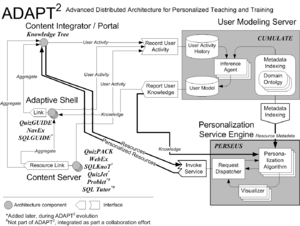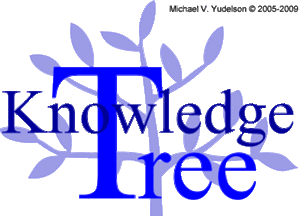ADAPT2
Contents
Overview
ADAPT2 (read adapt-square) - Advanced Distributed Architecture for Personalized Teaching and Training - is a framework targeted at providing personalization and adaptation services for developers of content that lacks personalization.
ADAPT2 consists of the following principal components.
- Knowledge Tree - portal
- CUMULATE - user-modeling server
- Content Servers
- Adaptive Shells, AKA Value-added services
- PERSEUS - personalization service engine
Knowledge Tree
| Knowledge Tree is a link aggregating portal. It presents content structured according to the folder-document paradigm. Knowledge Tree provides authentication and authorization and implements a simplified form of access control. It supports collaborative authoring and social annotation. (more) |
CUMULATE
CUMULATE is a central user modeling server responsible for collecting evidence of user activity and for generating user models, i.e., assertions about the knowledge and mastery of individual users. Personalization components of the architecture, such as personalized shells and personalized learning content, could get access to the user models (using CUMULATE protocols) to offer personalized access and other personalized services to the end users. ==> (more on CUMULATE)
Adaptive Shells
ADAPT2 supports multiple types of adaptive shells (aka value-adding services) which are the key components for providing adaptation and personalization. Adaptive shells stand between a portal and learning objects coming from multiple content servers. In contrast to the portal, which is not personalized, adaptive shells can provide personalized access to learning objects. The ability to insert various adaptive shells between the portal and the learning content makes possible to explore various personalization approaches. Examples of adaptive shells explored by our lab in the past include:
- NavEx for concept-based personalization
- QuizGuide and [JavaGUide]] for topic-based personalization
- Knowledge Sea II for social navigation support
- Progressor shells for a single-content social comparison
- Progressor+ shell for multi-type social comparison
Since 2015 most of our research uses Mastery Grids shell. Mastery Grids offers a flexible and customizable interface for delivering and exploring personalized content access. It combines knowledge-based personalization explored by NavEx and QuizGuide with social navigation and comparison ideas explored by Knowledge Sea II, Progressor, and Progressor+.
Content Servers
Content servers provide learning objects for students to interact with. Content servers that natively work with ADAPT2 include several systems developed by PAWS lab: WebEx, QuizPACK, c/jWADEIn, SQLKnoT, QuizJET, PCEX. ADAPT2 can also use learning objects developed by many other research teams. There are currently two ways to make interactive learning content usable in ADAPT2.
- For unrestricted use, learning content server has to implement with ADAPT2 content invocation protocol and CUMULATE knowledge reporting protocols. Examples of of content servers that implement these protocols are SQL Tutor (University of Canterbury, New Zealand), PCRS (University of Toronto), and ACOS server (Aalto University).
- For the use in MasteryGrids interface only, a learning content server has to implement LTI protocol for launching learning activities and reporting learner progress. Examples of LTI-compatible learning content that are currently used in courses supported by ADAPT2 are CodeWorkout (Virginia Tech) and DBQA] (University of St. Thomas).
PERSEUS
PERSEUS is a Personalization Service Engine. It provides adaptive support for non-personalized (educational) hypermedia systems by abstracting content presentation/aggregation from user modeling. PERSEUS protocols are based on RDF and RSS 1.0. Although, PERSEUS was initially developed for ADAPT2 framework, its data model permits seamless support of any other hypermedia application. Currently PERSEUS supports social navigation, topic-based navigation, concept-based navigation, and adaptive filtering techniques.
Standardization
Data models of ADAPT2 components are partially serialized as RDF. For more information refer to ADAPT2 RDF Binding.



